June is recognized as National Safety Month so it's a great time to emphasize safety in the home, workplace, and community. National Safety Month is an initiative created by the National Safety Council (NSC) in 1996 to raise awareness about the importance of safety. From situational awareness of hazards in your workplace to practicing safe driving habits, there are many ways we can all make a difference when it comes to keeping ourselves and our coworkers safe. Encourage everyone to observe work conditions, act, and prioritize safety, especially during June!
The Comp Alliance will be sending out weekly notices to our members, each Monday in June, to alert you of a particular hazard that causes frequent workplace injuries. Our goal is to enlighten our members about these common exposures and encourage reducing and removing the hazards that create these injuries.
Starting on Monday, June 5, you’ll see weekly safety tips on controlling various workplace hazards.
- Monday, June 5: Safe Lifting to Avoid Back Injuries
- Monday, June 12: Get a Handle on Slips, Trips, and Falls in the Workplace
- Monday, June 19: Preventing Being Struck By Falling or Flying Objects
- Monday, June 26: Reduce Pulling/Pushing Injuries
Most, if not all, of our members’ loss experiences include the above topics. Slip, fall, and back injuries from lifting or twisting continue to be the most frequent cause of workplace injuries. Be sure to use your resources and work to eliminate hazards that cause these injuries in the workplace. Inspect for slick or uneven walking surfaces, loose or broken stair treads and handrails, and illuminate walking surfaces like parking lots and exterior stairs. Many lifting-type injuries can be avoided through proper staff training on better lifting techniques or mechanical means, such as hand trucks and push carts.
Let’s all pay close attention to safety this June to reduce injuries. We’ll monitor our progress for the month and improve conditions throughout the next six months to keep everyone safer in the workplace in 2023.
Tip #1: Officer Mental Health
For this year’s National Police Week, the Comp Alliance will again start with the vital importance of police officers’ mental health and wellness. Traditional occupational safety and health risk management programs primarily concentrate on ensuring that work is safe, and workers are protected from workplace hazards that arise from the work itself. This includes dealing with hazardous chemicals, improved housekeeping, and PPE procedures. Police officers need to understand these physical controls. Additionally, officers deserve mental health protection from the hazards of stress, fatigue, burnout, and substance abuse. Employees who endure work-related struggles that negatively impact their well-being are at a substantially higher risk of poor health and injury.
The Law Enforcement Mental Health and Wellness Act of 2017 (LEMHWA) was signed into law in January 2018, providing support for law enforcement agencies’ ongoing efforts to protect their employees' mental health and well-being. Good mental health is just as essential as good physical health for law enforcement officers to be effective in keeping our communities safe from crime and violence[1].
To promote police officer mental health, consider these resources and share applicable information with your department staff at all levels:
- Municipal Employee Assistance Programs: These programs are important and should be promoted by police agencies. Every officer is different and not everyone will come to their police agency if they are unable to sleep or if stress is harming their lives. Multiple options should be made available to police officers through their agency. Consider peer support groups or officer-led programs where discussions on trauma-related stress can be held in confidence with trusted coworkers taking the lead.
- Supervisor Training: Field Training Officers (FTO) who recognize adverse stress reactions and signs of chronic stress can identify trauma or stress-related challenges in their subordinates. Administrators can follow up to provide troubled officers with resources and support including a change in shift assignment, time off to resolve an acute stressor, sleep concerns, or more formal support such as professional counseling.
- Stress-Related Meetings: Positive police management includes routine discussions with police staff on the importance of mental health improvements. Talking about stress management during employee reviews, meetings, and briefings provides an opportunity for the trained supervisor to encourage an honest discussion of any problems officers may be experiencing. Such a discussion opens the door for an officer who is struggling to reach out for support. It also provides an opportunity for supervisors to identify a potential problem before any adverse stress reactions could affect the officer’s safety.
- Create Motivation Programs: Develop ideas where officers are encouraged and motivated to attend stress-reducing programs that build comradery including yoga, exercise events, and sporting activities. Include family and spousal support organizations where officer families and spouses can come together to provide insight into common stressors and experiences. After an officer experiences a traumatic event, offering counseling for spouses might also be effective. When police families cope well with stress, it is more likely that the officers will remain focused while on duty.
This week we honor the vital work of our police departments. The Comp Alliance recognizes the incredibly important and difficult jobs that you all have. We appreciate all you do and hope these short safety bulletins will be a reminder of our appreciation and help to improve the safety of the department.
[1] U.S. Department of Justice - https://cops.usdoj.gov/lemhwaresources
Resources on Mental Health:
NYS Alliance on Mental Illness: https://www.naminys.org/nys/mental-health-awareness-month/
U.S. Department of Justice:https://bja.ojp.gov/program/pmhc
International Association of Chiefs of Police: https://www.theiacp.org/topics/mental-health
May is National Mental Health Month: https://mhanational.org/mental-health-month
Tip #2: PPE
The Comp Alliance works with a variety of departments, each with unique risks and hazards to control. One shared means of protection for all employees is the use of personal protective equipment (PPE). Police departments are not without the need for proper PPE, whose safe use can prevent injuries while on patrol, during a chase, and back at the police station.
Police PPE is much more than donning a ballistic vest, and should include the following:
- Footwear: A well-fitting work boot with anti-slip soles can provide comfort and safety for officers often on their feet. Appropriate footwear can aid in foot pursuits and managing environments with broken glass, like auto accidents, and
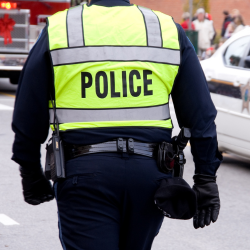 other debris.
other debris. - Disposable Gloves: To prevent the contraction of a bloodborne pathogen or drug exposure, like fentanyl, the barrier that gloves provide can be vital. Disposable nitrile or latex gloves used by police officers should fit comfortably and be durable. Training on Bloodborne Pathogens, including the use of disposable gloves, is required annually for officers.
- Tactical Gloves: Police gloves are generally designed for multiple uses including puncture resistance, shooting assistance, evidence collection, and grip improvement. Darker shades help to identify light-colored evidence and blend in with tactical gear.
- Reflective Gear: Police officers can be injured due to limited visibility from oncoming traffic while dealing with routine traffic issues. Reflective clothing should be worn for these situations. Follow current ANSI 107 standards for the appropriate reflective rates. Clothing reflections should cover the body 360 degrees and be rated at high visibility Level 3, including high-speed traffic and night-time reflectivity.
- Hearing and Eye Protection: While not worn on a routine basis, hearing and eye protection can help protect officers from loud noises, flying debris, or sunlight. Hearing protection can be difficult to utilize as some systems limit an officer’s situational awareness, so investigate active systems that allow for outside awareness. Officers working daytime shifts could benefit from sunglasses with UV 400 ratings for protection from the sun’s rays. Safety glasses should be worn where flying debris may be encountered to provide additional protection.
- Clothing: Ballistic vests are commonplace, and departments develop policies on their use and care. Follow manufacturer instructions for care and keep your vest dry before use. Wear a soft, comfortable shirt under the vest, and roll out new vests to improve comfort. Outerwear should be comfortable and provide clear identification. Any nighttime wear should have proper reflectivity.
As with any high-hazard job position, the proper use of personal protective equipment goes a long way to protect against recognized hazards. PPE must be approved by administration and be readily available for staff. At no time should PPE use be restricted for staff members. Remember, PPE only works if you wear it!
Tip #3: De-Escalation
One common topic of discussion is police-public interaction during confrontations in the field. This can include scenarios like arrests, crowd control, and investigations. With increased scrutiny from the public, improving techniques to handle these situations can positively benefit a department’s reputation and police officer safety.
De-escalation is defined as a method to prevent potential violence; using an approach aimed at reducing intensity to resolve conflicts. It involves purposeful actions, verbal communication, and body language to stabilize, slow or reduce the intensity of a potentially violent situation without using physical force or reducing necessary force.[1] De-escalation training is well known and has been introduced into officer schooling at the police academy. It should be common knowledge for any academy graduate and especially seasoned officers. Everyone can benefit from improved de-escalation knowledge.
intensity of a potentially violent situation without using physical force or reducing necessary force.[1] De-escalation training is well known and has been introduced into officer schooling at the police academy. It should be common knowledge for any academy graduate and especially seasoned officers. Everyone can benefit from improved de-escalation knowledge.
The appropriate use of de-escalation techniques can go a long way in keeping officers and their colleagues safe. Beginning encounters with de-escalation tactics benefit both officers and citizens. Officers should work to de-escalate before a situation spirals into adverse or demanding conditions. Proper training and the use of de-escalation techniques can calm hostilities before they become violent or make potentially violent conditions manageable. These techniques are vitally important to a police officer’s protection in the field and are another means of officer protection.
An officer should have an understanding of the following:
- De-escalation is a method to prevent potential violence.
- Your safety and the safety of others around you is the highest priority.
- Know your limits and where the confrontation is going.
- Obtain help from other officers and move to a safe location.
As part of a de-escalation training program for your department, purposeful actions include:
- Slow down and observe the initial situation. Take a second to evaluate the conditions and the environment around you and hold off on an immediate intervention.
- Remain calm and composed and maintain a safe distance to respect personal space.
- Use verbal communication. Be compassionate but firm in defusing a tense situation. Speak calmly but directly, avoid raising your voice, and slow down your speech to be understood.
- Maintain positive body language. Keep relaxed but alert, slow down your actions, use deliberate movements, and maintain a neutral and attentive facial expression.
Not all situations can be de-escalated. Active shooter situations require law enforcement to actively seek and neutralize the threat. While it is preferred that an officer attempt de-escalation when warranted, sometimes a suspect’s actions require harsher responses and interactions.
Police officers who effectively use de-escalation in the field have been found to have reduced stress, as encounters are often resolved without physical interactions. When public interactions are successfully resolved without conflict, the department’s reputation is improved throughout the community. Update policies, practices, and training on de-escalation techniques to improve officer safety and reduce workplace injuries.
[1] U.S. Department of Homeland Security
Tip #4: Crowd Control
Police officers can get into a variety of dangerous situations performing police operations including traffic stops, domestic disputes, brawls, and chases. Oftentimes crowd control occurs alongside many of these circumstances. Crowd control is also necessary for sporting events, controversial court verdicts, and parades. For example, should a routine traffic stop turn violent, people may gather to witness the event and record it. In this instance, police must deal with not only the offending party but also bystanders who may try to intervene. There are many forms of crowd control and using the proper procedures benefits your officers.
Crowd control procedures focus on the task of controlling large or gathering groups with a limited number of police officers. Use policies, planning, and tactics equally to mitigate damage and injuries sustained should a crowd become riotous or beyond the control of the officers present. Crowd control procedures should cover planned and unplanned events, from a holiday parade to a riot. Police presence at these events requires officers to have situational awareness of any growing concern.
 At demonstrations, political rallies, and protests, hostilities can escalate quickly. A solid police presence can be the difference between control and total mayhem. Special equipment such as helmets, batons, shields, and less-than-lethal weapons should be available for use during such events. All staff intending to use the conflict engagement PPE should attend relevant training. Some crowd control tactics your police agency should have in place to maintain order:
At demonstrations, political rallies, and protests, hostilities can escalate quickly. A solid police presence can be the difference between control and total mayhem. Special equipment such as helmets, batons, shields, and less-than-lethal weapons should be available for use during such events. All staff intending to use the conflict engagement PPE should attend relevant training. Some crowd control tactics your police agency should have in place to maintain order:
Plan and Set-Up: Routine events expecting crowds still require planning for traffic control, officer locations, officer responsibilities, and anticipated outcomes. While sudden events do not allow for pre-planning, a policy on such events allows departments to respond and handle them smoothly. Single-officer crowd events, like traffic violations that escalate, may require the removal of the officer until assistance is provided. Plan for these situations as well.
Communication, Equipment, and Skills: Communication should be prioritized to reinforce that officers are in charge. Communicating status updates as events change rapidly during large gatherings, moving units around the site, denoting changes in the environment, and denoting when an event has concluded helps maintain order. Additionally, positive communication like officer de-escalation can alleviate conflict.
Crowd Control Team Tactics: When police departments are trained in team tactics, fewer officers can accomplish more. Officers trained to form, fall into, extend, and move within a line, column, or wedge formation while in stressful environments can be extremely effective in deterring unruly groups.
Team Arrest Skills: Train on making a team physical arrest quickly and efficiently in the presence of a crowd, particularly one that is growing in size and hostility. Ensure that professionalism is a top priority.
Crowd Dynamics: Officers must recognize the dynamics that exist in every crowd. For example, many good people, who are followers, will engage in a violent disturbance if malevolent leaders are not deterred or arrested. Voice commands with a show of force are likely to turn back good bystanders from engaging further.
Personal Protective Equipment: More hostile encounters are likely to require specialty officer divisions using specialty equipment. Have enough equipment ready for the number of officers planned for the event.
Additional Food for Thought: Plain clothes observers, cameras, body cameras, detours and alternate routes, mutual aid availability, mobility of forces, and less-than-lethal munitions all play a role in your ability to successfully control gathering crowds.
Crowd control requires planning, training, knowledge of your community, and specialty equipment. From the routine parade to the unforeseen response to a community event, police departments that prepare beforehand are more likely to be successful in keeping events calm, peaceful, and lawful.
Tip #5: Less-Than-Lethal Force
In recognition of National Police Week 2023, the Comp Alliance developed safety tips aimed at providing information to protect officers from workplace injuries. The final tip of the week is a discussion on the use of less-than-lethal force, a strategy that can provide improved safety for officers when interacting with the public.
Less-than-lethal force, or less lethal force, is any use of force that is not considered deadly and involves physical effort to control, restrain, or overcome the resistance of another. This encompasses manual restraint, electronic control weapons, aerosol sprays, and impact projectors. These weapons provide an alternative force option that is less likely to result in a fatality while still effectively subduing a person with little to no harm to the police officer.
Studies have shown that when officers use less lethal technology, they are likely to suffer fewer and less severe injuries. Additionally, deadly force is not necessary in most instances so the impact on officers’ mental health is likely to be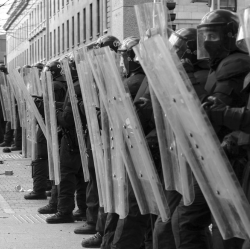 greatly reduced. Officers have often stated that using a Taser or pepper spray saved them from performing a riskier solution during an escalating situation.
greatly reduced. Officers have often stated that using a Taser or pepper spray saved them from performing a riskier solution during an escalating situation.
There are several types of less lethal force devices including:
- Electronic Control Devices (ECDs) like Tasers and stun guns.
- Remote restraint devices like a BolaWrap.
- Chemicals, for example, pepper spray and tear gas.
- Vehicle-stopping technology equipment that stops cars during a pursuit, like spike strips.
- Barriers such as nets, foams, and other physical barriers.
- Blunt force items, namely regular or collapsible batons, and projectiles.
Staff training is an absolute must when your department seeks to utilize one or more of these devices. Training must be completed upon initial introduction to the department, when an officer displays incompetence with the device, or when an officer changes job functions. Document all such training and conduct routine refreshers as recommended. The goal of training is to confirm that the administration has the utmost confidence in the officers’ understanding of the safe use of such devices and their ability to follow policy on their utilization.
We hope that these week-long safety tips during National Police Week were a help to your department and municipality. The Comp Alliance is here to assist our members and their employees in reducing and preventing workplace injuries. Please reach out to the Director of Loss Control, Robert Blaisdell, at This email address is being protected from spambots. You need JavaScript enabled to view it. or (518) 330-8591 for more information on this topic or any of the topics discussed during the week. We wish our police departments the very best in providing safety and security for their communities and police officers.
As more schools embrace environmentally sensitive practices related to school maintenance, facility managers must consider not only the buildings they maintain but the land that makes up much of school campuses. Taking precautions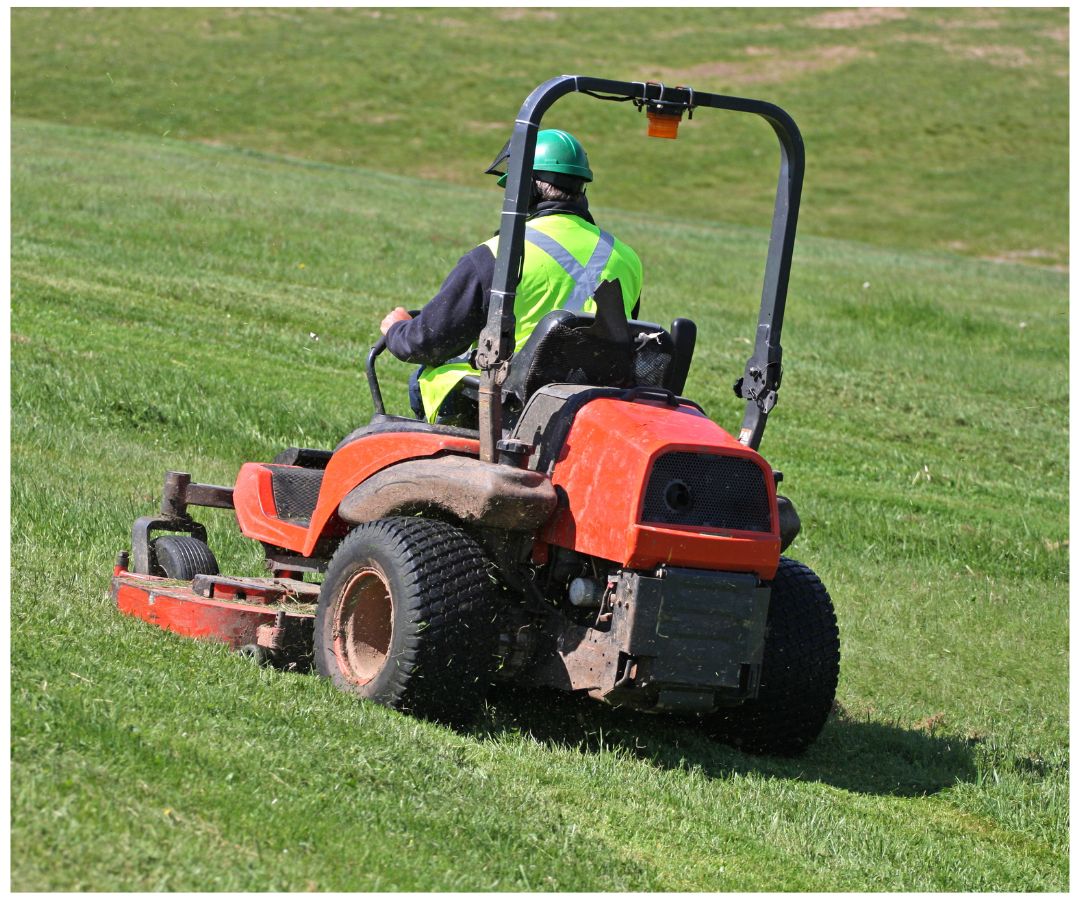 for custodial and grounds staff treating lawns will help to prevent injuries and illnesses this season.
for custodial and grounds staff treating lawns will help to prevent injuries and illnesses this season.
Landscape maintenance is a critical part of your staff’s health and safety. Implement a pest management program (IPM) that uses a combination of strategies including biological, cultural, physical, mechanical, educational, and chemical to keep pest numbers at an acceptable level while causing minimal health impact to staff. Chemical fertilizers pose a health risk to facility staff during the application process. Alleviate the need for these by planting locally adapted or native plants. If that is not an option, prioritize using alternatives or organic fertilizers. Additionally, mulching or composting landscape waste reduces the need for fertilizers. Composting can take place onsite or be sent to a facility dedicated to composting organic materials.
When the application of pesticides is necessary, use the least toxic pesticides. They should have low to no acute or chronic toxicity to humans, affect a narrow range of species, and be formulated to be applied in a manner that limits exposure to humans and other non-target organisms. Conduct spot treatments when applying chemicals and only apply fertilizer to necessary areas. To best protect employees from this exposure, reference the Safety Data Sheet (SDS) for the chemicals you use, especially Section 4 (First Aid Measures) and Section 8 (Personal Protective Equipment).
No more than one-third of the length of the grass should be cut in one sitting. Monitor turf conditions and moisture levels when mowing to determine if aerating, nutrient feeding, or other measures are needed. Select turf-maintenance products that maximize the use of organic materials, including animal manures and compost. It is important to properly maintain mowing equipment so that it is manageable for staff, comfortable to operate, and limits personal exposure to things like noise and vibration. Broken or worn suspension components of riding lawnmowers can cause rough riding and bouncing during operation, contributing to back injuries.
All staff should use personal protective equipment (PPE) which should be worn to minimize exposure to possible hazards in the landscape management workplace. Be sure PPE conforms with the recommended safety compliance marking in the operator manual for any equipment that is used.
Safety glasses should be chosen to help protect eyes from both debris impact and dust. Mowers, trimmers, and blowers dislodge debris and propel the debris at high speed in several directions. Properly selected safety glasses are impact and dust resistant and will provide better protection than standard sunglasses or non-impact-resistant prescription eyeglasses. Face shields can also protect the face from flying debris. Face shields are used to protect the entire face and, in those cases, should be used in addition to safety glasses. Face shields are generally not a substitute for high-impact-resistant safety glasses.
Wearing earplugs or safety earmuffs is a good precaution when using mowers, trimmers, and blowers. This equipment exceeds daily permissible exposure limits (PEL) to sound. The loud and high-pitched engine noises can damage eardrums and cause hearing loss later in life.
In addition, be sure to protect staff from tick exposures. 2023 is predicted to be a bad year for ticks. Precautions should be taken to reduce the risk of tick bites, which can lead to Lyme disease. Cover all skin when working outside. Treat exposed skin with a DEET protectant, pretreat clothing with a permethrin product, and be sure to conduct a self-check for ticks after working outdoors.
For additional information on outdoor maintenance safety, please contact the Comp Alliance Director of Loss Control, Robert Blaisdell at This email address is being protected from spambots. You need JavaScript enabled to view it..
May is National Healthy Vision and Better Hearing Month. Vision and hearing are two of our main human senses and provide security from outside hazards around us. Injuries to these senses are almost always preventable if the proper equipment is utilized.
Hearing Safety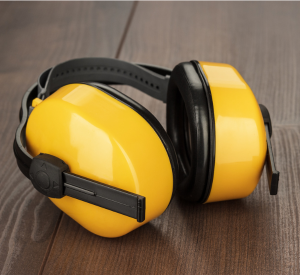
Exposure to loud noise kills the nerve endings in our inner ear. As exposure increases, so does the amount of dead nerve endings. The result is permanent hearing loss that cannot be corrected through surgery or medicine. OSHA requires employers to implement a hearing conservation program when noise exposure is at or above 85 decibels averaged over an eight-hour time-weighted average (TWA). The first part of a protective hearing program is to know your workplace noise levels. Several sound-measuring instruments are available to measure the noise levels in a workspace. These include sound level meters, noise dosimeters, and octave band analyzers. The National Institute for Occupational Safety and Health (NIOSH) Sound Level Meter App is one tool available on mobile iOS devices that measures sound levels in the workplace. Under OSHA’s Noise Standard, the employer must reduce noise exposure through engineering controls, administrative controls, or hearing protection devices (HPDs) to attenuate the occupational noise received by the employee’s ears. Some hearing protection devices can be worn in tandem.
Hearing protection devices (HPD) include:
- Formable/Disposable Ear Plugs: Wash your hands before inserting the ear plugs. Rub the insert with your fingers to shrink them, tilt your head to the side, and insert it into the ear canal.
- Semi-Insert/Ear Canal Caps: These are worn against the opening of the external ear canal and kept in place by a lightweight headband with mild tension.
- Earmuffs: The ear cup fits around the outside of the ear, enclosing it and sealing it against the side of the head with a cushion.
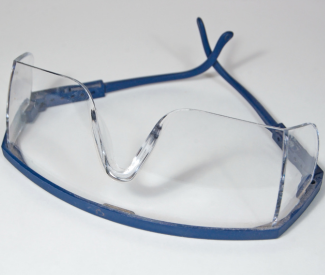 Vision Safety
Vision Safety
Under the OSHA General Duty Clause, employers need to provide workplace safety controls for recognized hazards. For vision hazards, the employer must ensure that each affected employee uses appropriate eye or face protection with hazards like flying particles, molten metal, liquid chemicals, acids or caustic liquids, chemical gases or vapors, or potentially injurious light radiation. NIOSH has reported that about 90% of workplace eye injuries were preventable if the appropriate eye protection was worn.
Vision protection systems include:
- Safety Glasses: ANSI-rated safety glasses protect from projectiles such as metal fragments, dirt or sand, and dust. These can be prescription and UV-rated.
- Safety Goggles: ANSI-rated goggles protect against liquid chemical exposures and create a seal all around the eyes to prevent exposure.
- Face Shield: This may be used for impact protection. Face shields are required when facial skin protection is needed. They can be used in conjunction with eyeglasses or goggles.
- Welding Shield: For protection from welding’s radiant energy, workers must use personal protective equipment such as safety glasses, goggles, welding helmets, or welding face shields. This equipment must have filter lenses with a shade number that provides the appropriate level of protection. A shade number indicates the intensity of light radiation that is allowed to pass through a filter lens to one’s eyes.
- Sunglasses: We may not address these as safety glasses, but sunglasses with a good UV rating will provide eye protection from the sun’s harmful UVA and UVB rays when workers are outside for an extended period. UV 400 is the best rating.
Using appropriate hearing and eye protection equipment helps reduce related workplace injuries. Remember that a large majority of workplace hearing and vision injuries are preventable, just by wearing the proper equipment!
For additional information on hearing and vision safety, please contact the Comp Alliance Director of Loss Control, Robert Blaisdell at This email address is being protected from spambots. You need JavaScript enabled to view it..
April is National Safe Digging Month which raises awareness of the safe ways to excavate to prevent injuries and save lives. Municipal highway, DPW, water, and sewer departments routinely excavate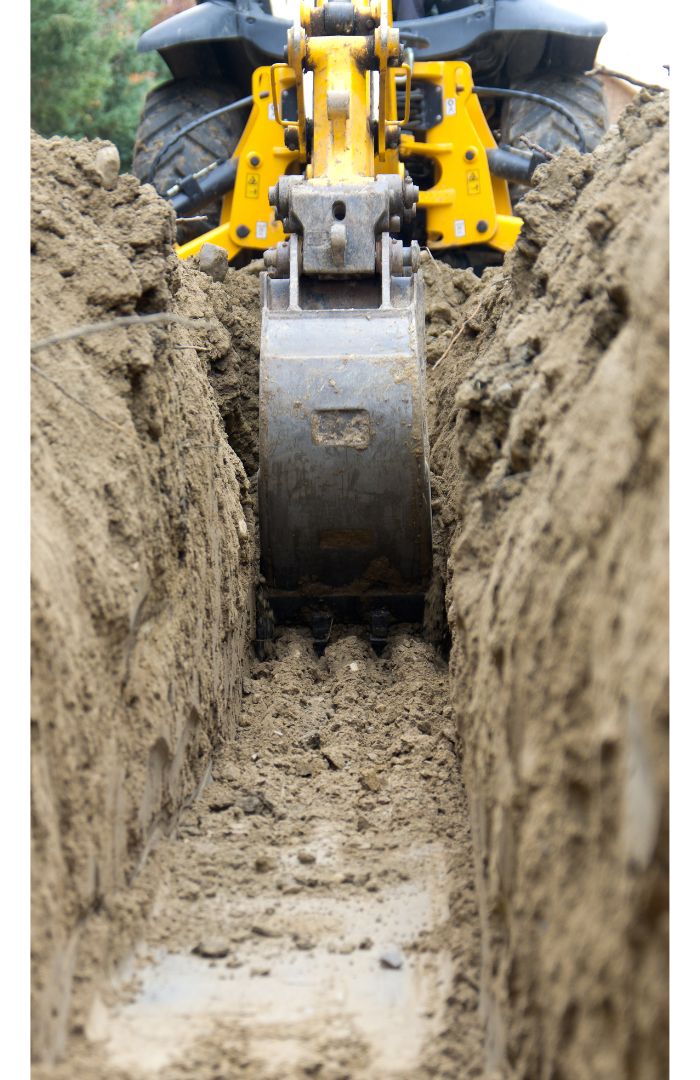 earth to install or repair infrastructure.
earth to install or repair infrastructure.
The process of moving earth can be dangerous due to several hazards. As a result, OSHA has standards on safe excavation practices that protect workers.
OSHA defines an excavation as any manmade cut, cavity, trench, or depression in an earth surface that is formed by earth removal. A trench is a narrow excavation, in relation to its length, made below the surface of the ground. Typically, a trench is deeper than it is wide, but that width when measured from the bottom is no greater than 15 feet. Every trench is an excavation, but not every excavation is a trench.
Excavation Hazards
In 2022, there were 39 nationwide deaths caused by full or partial trench excavation cave-ins. According to OSHA, this is an increase of 14 from the previous year. Among excavation-related deaths in OSHA’s 2022 Accident Search were electrocution, a case of heat stroke, someone struck by a falling concrete pipe, and a fall into a trench. These deaths could have been prevented if current OSHA standards on trench and excavation safety had been followed. OSHA’s excavation standards are covered in Part 1926, Subpart P of the 29 Code of Federal Regulations which includes 1926.650-652 and Appendixes A-F. Many other preventable injuries were sustained by workers entering, working in, and exiting excavation sites as well.
The hazards of trenching and excavation are well documented. One is the weight of soil. A cubic yard can weigh about 3,000 pounds, or as much as a car. Soil can be so heavy that it can crush a person and kill them within minutes of a trench collapse. Even if a person’s head and arms are above the dirt, the sheer weight of the soil restricts breathing and heartbeats.
Other dangers include the volatility of excavations, changing soil conditions, equipment placement, atmospheric hazards, and weather. For example, water accumulation from weather or groundwater can weaken the soil and lead to a cave-in. This can happen before the excavation has begun, or more dangerously, during an excavation.
When soil conditions change midstream, they create extreme hazards and often require the job to be shut down until stable conditions allow for safe excavation reentry. Soil conditions can change rapidly and often faster than one can react to them, making escape impossible. Hazards can also stem from:
- Construction equipment and machinery.
- Buried electrical or gas lines.
- Gases and fumes.
For additional information on excavation hazards, watch the following OSHA video by clicking here.
Protective Measures
OSHA requires protective systems for excavations five feet or deeper unless the excavation is composed entirely of stable rock. A protective system is required for excavations shallower than five feet if a competent person finds any indication of a potential cave-in. A competent person is an individual chosen by a municipality, who can identify existing and predictable hazards and is authorized to take prompt corrective measures to eliminate them. There are four main protective systems.
- Sloping: Cutting back the trench wall at an angle that’s inclined away from the excavation.
- Benching: Forming one or a series of horizontal levels or steps into the sides of an excavation, usually with vertical or near-vertical surfaces between levels.
- Shoring: Installing aluminum hydraulic or other types of supports to prevent soil movement and cave-ins.
- Shielding: Using trench boxes or other supports to prevent cave-ins.
The UDig NY Certified Excavator Program in Safe Digging Best Practices (CEP) has set a new standard for training New York State professional excavators on the proper procedures of excavation. When a person has completed the CEP, they are certified by the One Call Center for five years, demonstrating a fundamental understanding of the Safe Digging Best Practices that should be used per the Common Ground Alliance Best Practices and New York State Code Rule 753. More information can be found here. For another training resource, visit Safety Source Online and watch "Trenching and Shoring – Excavation Safety (SSC003E)." To access their online training videos, please contact This email address is being protected from spambots. You need JavaScript enabled to view it. for a user ID and password.
For additional information on excavation safety or training, please contact the Comp Alliance Director of Loss Control, Robert Blaisdell at This email address is being protected from spambots. You need JavaScript enabled to view it..
Upcoming Events
| No events |

